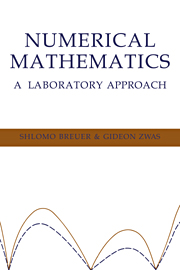Book contents
- Frontmatter
- Contents
- Preface
- Chapter 1 Mathematics in a numerical laboratory
- Chapter 2 Iterations for root extraction
- Chapter 3 Area approximations
- Chapter 4 Linear systems – An algorithmic approach
- Chapter 5 Algorithmic computations of π and e
- Chapter 6 Convergence acceleration
- Chapter 7 Interpolative approximation
- Chapter 8 Computer library functions
- Solutions to selected exercise
- Index
Chapter 3 - Area approximations
Published online by Cambridge University Press: 05 June 2012
- Frontmatter
- Contents
- Preface
- Chapter 1 Mathematics in a numerical laboratory
- Chapter 2 Iterations for root extraction
- Chapter 3 Area approximations
- Chapter 4 Linear systems – An algorithmic approach
- Chapter 5 Algorithmic computations of π and e
- Chapter 6 Convergence acceleration
- Chapter 7 Interpolative approximation
- Chapter 8 Computer library functions
- Solutions to selected exercise
- Index
Summary
Introduction
Our second numerical laboratory assignment is the computation of an area under a given curve to a desired accuracy. Unlike the calculation of the areas of various polygons, the computation of the area of a circle, an ellipse, or the area under the curve y = 1/log x from x = 2 to x = 7, say, is not at all trivial and requires methods of integral calculus or numerical approximations. Such areas arise not only in a geometrical context but also in various applications in engineering, biology, and statistics. In keeping with our policy of making the material as accessible as possible to precalculus students, without sacrificing rigor, we shall somewhat limit the generality so that results can be proved by elementary means and generalizations pointed out.
We shall henceforth be interested in the computation of the area under the graph of a positive function y = f(x), from x = a to x = b, but limit ourselves for the time being to monotonic (increasing or decreasing) or convex functions.
Rectangular approximations
Although the ensuing analysis is carried out in terms of a general, positive, monotonic function f(x), a ≤ x ≤ b, it is advisable that the laboratory participants bear in mind a concrete example such as f(x) = 1/x, 1 ≤ x ≤ 2.
- Type
- Chapter
- Information
- Numerical MathematicsA Laboratory Approach, pp. 40 - 60Publisher: Cambridge University PressPrint publication year: 1993

